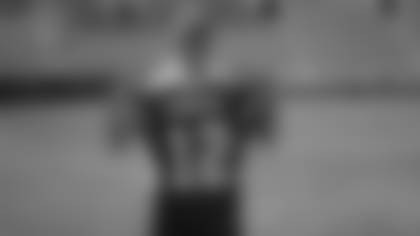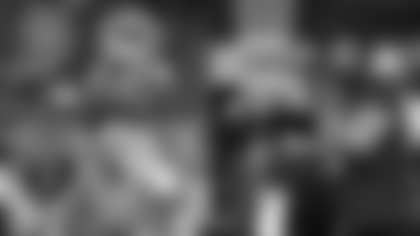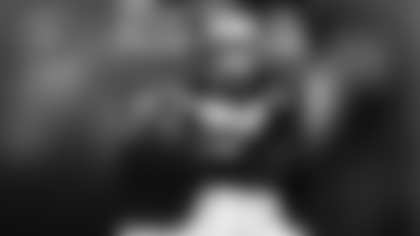Packers team historian Cliff Christl has assembled an oral history series on the NFL Draft, highlighting significant and noteworthy years as a prelude to Green Bay hosting the 2025 draft in late April. New installments will be posted most weekdays. For access to the full series thus far, click here.
1998
The 63rd NFL Draft started at 12:06 p.m. (EDT) on April 18, 1998, and ended at 4:59 p.m. the next day with an overnight break. Three rounds were completed the first day with the session ending at 8:38 p.m. The final four rounds were held on April 19, starting at 11:06 a.m. In all, the draft took 14 hours 25 minutes.
The command center was the Theater at Madison Square Garden in New York City. In 1993, the number of rounds had been reduced from 12 to eight and then in 1994 to seven.

Fans can now register for free entry to the 2025 NFL Draft by downloading the NFL OnePass app or by registering online!
The ultimate risk vs. reward debate
Scouts spend endless hours every draft weighing risk vs. reward.
The debate over the best quarterback available in 1998 and the everlasting consequences of it spotlights why. Arguably, there's never been a closer call between the projected first and second overall picks only to have their careers follow poles-apart paths.
Tennessee's Peyton Manning (6-5, 230) was drafted No. 1 by Indianapolis. Washington State's Ryan Leaf (6-5, 254) was selected No. 2 by San Diego, which traded up to draft him.
Manning played 17 years, passed for 71,940 yards, compiled a 186-79 record as a starter and was inducted into the Pro Football Hall of Fame in 2021. Leaf played three years, passed for 3,666 yards, finished with a 4-17 record as a starter and belongs on the short list of the biggest busts in draft history.
On Dec. 22, 1997, the day after the Colts lost their final game to finish 3-13 and clinch the No. 1 draft pick ahead of four 4-12 teams, owner Jim Irsay cleaned house and named Bill Polian as team president. At his introductory press conference, Polian singled out Manning, calling him "as complete a player as there's been in college football in quite some time."
A little more than six weeks later, on the eve of the NFL Scouting Combine, Polian confirmed Manning was still on his radar screen but so was Leaf.
"They both can play in this league," Polian told Mike Chappell of the Indianapolis Star. "It's a question of chocolate or vanilla. It's a question of: Who do you like?"
Over the next two-plus months, Polian said little to tip his hand as to which one he preferred. Although there were clues throughout the process that Manning might be the frontrunner, it wasn't until the night before the draft that word leaked it was a certainty.
In the years since, Polian, Leaf and Leaf's agent Leigh Steinberg have provided varying versions of what transpired over that time period, from early February to late April 1998. And those, in turn, have led to charges of lies and even recantations.
But there is little doubt about the essence of the storyline: NFL general managers, coaches and scouts were sharply divided over the two quarterbacks and much of the debate centered on which one had the bigger upside and who was more at risk of failing.
Bobby Beathard, one of six general managers in the Pro Football Hall of Fame, traded up to draft Leaf No. 2, which is validation enough of his pre-draft standing.
In February, Len Pasquarelli of the Atlanta Journal-Constitution polled 10 NFL personnel directors or scouts and asked them to compare the two quarterbacks by assigning a 1-to-5 grade in six categories. Manning's final tally was 24.1; Leaf's, 23.9. Leaf received higher grades for his arm strength, accuracy and athleticism; Manning for leadership, competitiveness and instant impact.
Here were quotes from Pasquarelli's story.
New Orleans director of college scouting Bruce Lemmerman: "Even with people hanging on him, Leaf can just flick his wrist and the ball takes off like a rocket."
Tennessee director of scouting Glenn Cumbee: "Peyton is probably more of an encouraging kind of leader. He's going to work his butt off, study film and be the best guy mentally he can."
Kansas City scout Scott Campbell: "We're not talking about great movement skills with either guy, and mobility is getting to be increasingly important."
Minnesota quarterbacks coach Ray Sherman: "Down by six in the final two minutes, they seem to be the kind of guys who want the ball and don't mind pressure."
Bob Glauber of Newsday polled 20 personnel people and published his results on March 29.
Buffalo general manager John Butler: "I'd take Ryan Leaf. I like the big, physical aspects about him. He's got good mobility, and there's something about him, kind of tough to say just what, just something you like in a quarterback. They're both talented players, but I give the edge to Leaf."
New York Giants coach and former college quarterback Jim Fassel: "I like Manning's athletic ability. I think he can come in and play right away. He's a mature kid, and the things he does wrong are easily correctable. One thing he does is he carries the ball awfully high when he drops back, and people talk about him having nervous feet in the pocket. But it's because he's holding the ball so high that he swings back and forth and looks nervous. But he's not a nervous guy."
Baltimore general manager Ozzie Newsome: "I like the fact that Peyton stayed in school for his fourth year, but you can't just automatically say that Ryan is worse off because he's coming out a year early. Look at Drew Bledsoe. He came out a year early, and he's a great quarterback. Manning is a little more ready to play, but Leaf is obviously a big, strong guy with a big arm. Those things would be real enticing."
Beathard: "I like them both. I think they're both big-armed guys, both emotional leaders, and both love to play the game. You just want to make sure you're in position to draft one of them, and we're in that position now. We're going to take one of them."
Peter King of Sports Illustrated polled what he referred to as a six-man blue-ribbon panel for their choices for the magazine's April 13 edition.
UCLA coach Bob Toledo, whose Bruins faced Tennessee and Washington State in each of the previous two seasons: "Ryan was unflappable. He was like an oak tree in the pocket – we'd hit him hard and our guys would bounce off. Peyton always stood in until the last second and took hits well, too."
Former San Francisco coach Bill Walsh: "I don't see (Brett) Favre or (John) Elway. I see those guys on the next level. But Manning seems to be more pro-ready than Leaf."
Tampa Bay director of player personnel Jerry Angelo on Leaf weighing in at 261 pounds at the combine: "I was at the combine for the weigh-in, and it really surprised me. Here's what could be the biggest day of your life, the day you're going to expose yourself to your future employers for the first time, and you show up out of shape and overweight. To me, that's a signal. The quarterback has to be the CEO of your team. You have to trust him. I'd have some hard questions if that happened and we were going to pick him."
Former head coach Sid Gillman, known as "The Father of the Modern Passing Game," while watching a tape of Manning: "Now this is a pro quarterback. Is that a beautiful throw or is that a beautiful throw? I'd draft this kid in a second."
Denver coach Mike Shanahan on those questioning Manning's arm strength: "Completely nuts. Peyton will make every throw there is."
Former Giants quarterback Phil Simms while watching a tape of Manning: "His arm's plenty good. … In the NFL, you make your living throwing the intermediate pass and look at how many good intermediate throws we're seeing Peyton make."
It was only days before the draft when Polian informed Irsay of his decision. He did so, he later wrote, shortly after reaffirming that he and his recently hired head coach Jim Mora were on the same page. Polian's decision was based in part – if not large part – by weighing the risk vs. the reward involved with each.
Polian (The Game Plan: The Art of Building a Winning Football Team by Bill Polian with Vic Carucci, 2014): "After that, I met with Jim Irsay. 'What's your decision?' he said. 'The decision is unanimous,' I said. 'It's Peyton.' … 'What's the upside and the downside with both of them?' he asked. 'Here's the issue: I can't tell you if either of these guys is going to win a Super Bowl or become a Hall of Famer. We are just trying to find a quarterback that we can win with. But I'll tell you this: If we bust out with Leaf, we have busted out everything. If he busts out, we've lost. If we are wrong on Peyton Manning, the worst we have is Bernie Kosar – a really good, winning quarterback.'"
Polian wasn't alone in arriving at that decision.
Miami scouting director Tom Braatz (Indianapolis Star, April 19, 1998): "One of them (Leaf) has a chance to fail. (Manning) has no chance to fail."
Randy Moss falls to No. 21
Had Randy Moss entered the 1998 draft without baggage, he stood a good chance of being drafted among the first five picks. Instead, he was selected No. 21 by Minnesota.
Over the previous three years, Moss was convicted of misdemeanor battery, received a jail sentence for testing positive for marijuana and was arrested for a domestic altercation, where the charges were eventually dropped.
In the process, Moss had a scholarship offer to Notre Dame rescinded and was kicked off the team at Florida State.
He wound up at Marshall, where he set an NCAA record in 1997 with 25 touchdown receptions. He also was 6-5, weighed 194 and was timed at 4.28 in the 40-yard dash. What's more, Marshall coach Bob Pruett told NFL teams that Moss hadn't missed a practice or caused a problem in two years there.
Minnesota coach Dennis Green, before the draft (Fort Worth Star-Telegram, April 16, 1998): "I think Moss, Andre Wadsworth and Charles Woodson are the most talented players in the draft. I think all three of those young men will be instant stars in the NFL."
Green, after selecting Moss (Minneapolis Star Tribune, April 19, 1998): "It's plain and simple. This is a young man who's a great player who made some mistakes in the past. He was 18 and 19 years old. He is still only a 21-year-old young man. We think his life is ahead of him, and we're taking the high road. We're saying we've got a full glass of water here, and we've got a player who's going to help us win a championship."
Green (Star Tribune, April 19, 1998): "I think there are very few receivers who have his big-play possibilities after the catch. When you look at this height, you are going to think of Herman Moore. Jake Reed is big at 6-4. So we will be a big pass receiving team. But the other dimension (Moss) will bring is tremendous speed down the field. Moss is one of the fastest players in the draft regardless of position."
Vikings offensive coordinator Brian Billick (Star Tribune, April 19, 1998): "I think fate has taken care of Randy Moss. I think the right structure is here because he's coming into an environment that's ideally suited for him."
Moss' agent James "Bus" Cook (Associated Press, April 19, 1998): "He really fell fast today. We didn't expect him to fall past Dallas (at No. 8). … the past just kept haunting Randy and it haunted the other teams."
Pruett (Chicago Tribune, April 19, 1998): "The problem (NFL teams) think they might have by taking him (won't) be anything like what they are going to have guarding him."
Three of Minnesota's then four NFC Central Division rivals passed on Moss. Chicago drafted Penn State running back Curtis Enis (6-1, 249) at No. 5. The Lions chose Tennessee cornerback Terry Fair one spot ahead of Moss. Green Bay traded up to 19th, two spots ahead of the Vikings, and took North Carolina defensive end Vonnie Holliday.
The Bears considered drafting Moss, according to the Tribune's Don Pierson, and desperately needed a wide receiver but were turned off by Moss' pre-draft visit to Chicago, when he overslept and didn't show for a morning meeting. At the same time, Bears officials claimed Enis was "head and shoulders above" anybody else on their board at that point.
Apparently, in Enis' case, it didn't matter that he was suspended from the Citrus Bowl for accepting a gift from an agent, amassed 77 unpaid parking tickets and battled weight issues. Based on comments by members of the Bears' brass, they were convinced they had picked the right player regardless.
Then again, when the Vikings grabbed Moss, the Bears immediately sensed that they now had another glaring need.
Bears vice president of player personnel Mark Hatley (Chicago Tribune, April 19, 1998): "We felt we took the best player, one that was quite a bit better than anyone who was on the board."
Bears coach Dave Wannstedt (Associated Press, April 19, 1998): "(Enis is) a great back who can make your entire offense a heck of a lot better and make people around him better."
Wannstedt on the Bears' sudden need for defensive help (Chicago Tribune, April 19, 1998): "When (the Vikings) took Moss, (defensive coordinator Bob) Slowik said we'd better get a safety."
Five picks into the second round, the Bears apparently were convinced of it. They grabbed University of Washington safety Tony Parrish.
As for the Packers, before the draft even started, general manager Ron Wolf traded his second-round pick to Miami to move up 10 spots to 19th in the first round. This was hours before they revealed that Reggie White was retiring, creating a sudden and desperate need for a defensive end. It also was hours before Moss fell as far as he did in the draft.
It didn't matter, Moss wasn't even on the Packers' board.
Wolf on his thoughts when the trade to move up was made (Chicago Tribune, April 19, 1998): "We were looking at (UCLA safety) Shaun Williams and never expected the guy we took to be there. Everybody says that, but it's the honest truth. We're just delighted. We had to add someone to the defensive unit."
Wolf after taking Holliday (Wisconsin State Journal, April 19, 1998): "We have taken a giant step forward today in putting the pieces of the jigsaw puzzle back together again."
Wolf (Christl interview, April 20, 2005): "We ruled (Moss) out way too early. If I had to do it all over, I never would have done that. It was early in our draft preparation. January, February. Let's face it, up there (in Green Bay), a guy runs a traffic light and that's the opening shot on the 6 o'clock news. And it's headlines in the paper. But I never saw up in Minnesota where Moss did anything (wrong) until the end. I guess last year, he was a pain in the neck. But what a player? Players like that don't come down the pike that often."
Wolf (Christl interview, July 23, 2020): "Who are some of the great receivers you've ever seen? Have you ever seen a receiver any better than Randy Moss?"
The Lions, meanwhile, were fairly set at wide receiver with Moore as their No. 1 and Johnnie Morton as their No. 2. Then again, so were the Vikings. They had future Hall of Famer Cris Carter and Reed.
Detroit coach Bobby Ross (Detroit News, April 19, 1998): "We really thought (Fair) was the best cover cornerback in the draft. We think it really helps us in our nickel package and our dime package."
Lions vice president of football administration Larry Lee (Detroit News, April 19, 1998): "I just think the character issue is something we had a concern about. If it would resurface. But let me say we are very happy with Terry Fair. Looking at Randy Moss, he would probably turn into an all-pro receiver, and now he is in our division. … You have to worry if a guy is going to have a Pied Piper. You don't want a guy to come in, no matter what his talents are like, and disrupt the harmony and peace you already have with a group."
Among the teams drafting in the top 10, Dallas appeared to be as likely a landing spot as any for Moss. Michael Irvin had just turned 32, and stopgap Anthony Miller, their other starting receiver, had just turned 33.
But North Carolina defensive end Greg Ellis filled a need, as well, and that's who the Cowboys opted to take.
Cowboys owner Jerry Jones (Fort Worth Star-Telegram, April 19, 1998): "This (Ellis) is a safe pick. … I just didn't have the stomach to take the risk (on Moss). I lost my nerve."
Cowboys behavioral consultant and former running back Calvin Hill (Fort Worth Star-Telegram, April 19, 1998): "Had Jerry Jones turned to me and asked, 'Should we take (Moss)?' I would have said, 'Yes.' Randy Moss has had some things in the past. But not enough where I think there would be a problem."
The then-Tennessee Oilers were the only team to draft a wide receiver ahead of Minnesota when they chose Utah's Kevin Dyson at No. 16.
Oilers coach Jeff Fischer (Nashville Tennessean, April 19, 1998): "Character is a factor, a criteria on which we evaluate players. Kevin has a higher character grade than he does an athletic grade. Randy Moss is a good player and will have a good NFL career. But there were circumstances."
During his 14-year career, eight of them with the Vikings, Moss gained 15,292 yards on pass receptions and caught 156 touchdown passes.
Enis lasted three years with the Bears, rushed for 1,497 yards and scored six TDs. Dyson played six seasons, four with Tennessee, gained 2,325 yards on receptions and caught 18 touchdown passes.
Ellis played 12 years and registered 84 sacks; Holliday, played 15 years, but only five with the Packers, and had 62½ sacks. Fair played six years and intercepted seven passes. None of them were ever named Associated Press All-Pro, and Ellis was the only one named to a Pro Bowl. He was selected once in his 10th season.
Top defender in the draft: Andre Wadsworth or Charles Woodson?
Whether Florida State defensive end Andre Wadsworth (6-4, 282) or Michigan cornerback Charles Woodson (6-0, 197) was the best available defensive player in the 1998 draft might have been as debatable as the back and forth over Manning or Leif. Wadsworth was drafted third by Arizona; Woodson, fourth by the Oakland Raiders.
But their careers also went in divergent directions. And it all boiled down to their health.
Hatley (Atlanta Journal-Constitution, April 10, 1998): "There's no question that (Wadsworth) is the best player and safest pick in the draft."
Wolf (Milwaukee Journal Sentinel, April 15, 1998): "(Wadsworth's) like a Bruce Smith or Reggie White. He comes in and changes your team around. If you're 4-12, in two years you'll be 12-4."
Baltimore director of college scouting Phil Savage (Baltimore Sun, April 12, 1998): "Woodson is really a modern-day Jim Thorpe."
ESPN college analyst and former NFL center Bill Curry (Tampa Tribune, April 13, 1998): "I played with Herb Adderley…and against Mel Renfro, and Woodson is the best cornerback I've ever seen."
On draft day, Wadsworth's and Woodson's new teams were equally as thrilled.
Cardinals vice president of player personnel Bob Ferguson (Arizona Republic, April 19, 1998): "To get a kid like (Wadsworth) is overwhelming. … When you build championship teams, they start with players like Andre."
Raiders coach Jon Gruden (Oakland Tribune, April 19, 1998): "Getting Woodson is a great way to start the day. How can you not be excited getting the Heisman Trophy winner who is one of the great playmakers in the history of college football?"
At the end of his 18-year Hall of Fame career, Woodson had played in 254 games, starting 251 and missing 34. Wadsworth lasted three seasons and 36 games.
As rookies, Woodson was named AP Rookie of the Year by two votes over Holliday. Wadsworth, a holdout until the night before the opener, finished third with one vote but was part of what was dubbed a young, "dream defensive line" that played a big part in the Cardinals finishing above .500 for the first time in 14 years and winning their first playoff game since 1947. In addition to Wadsworth, the unit included Simeon Rice, Eric Swann and Mark Smith, who were all 28 or younger and had combined for 28 sacks.
Over the next two years, Wadsworth underwent one operation on his left knee and three on his right knee, including a microfracture procedure to promote the growth of a cartilage-like substance to temper the pain. On the other hand, Woodson had yet to miss a game after four seasons.















